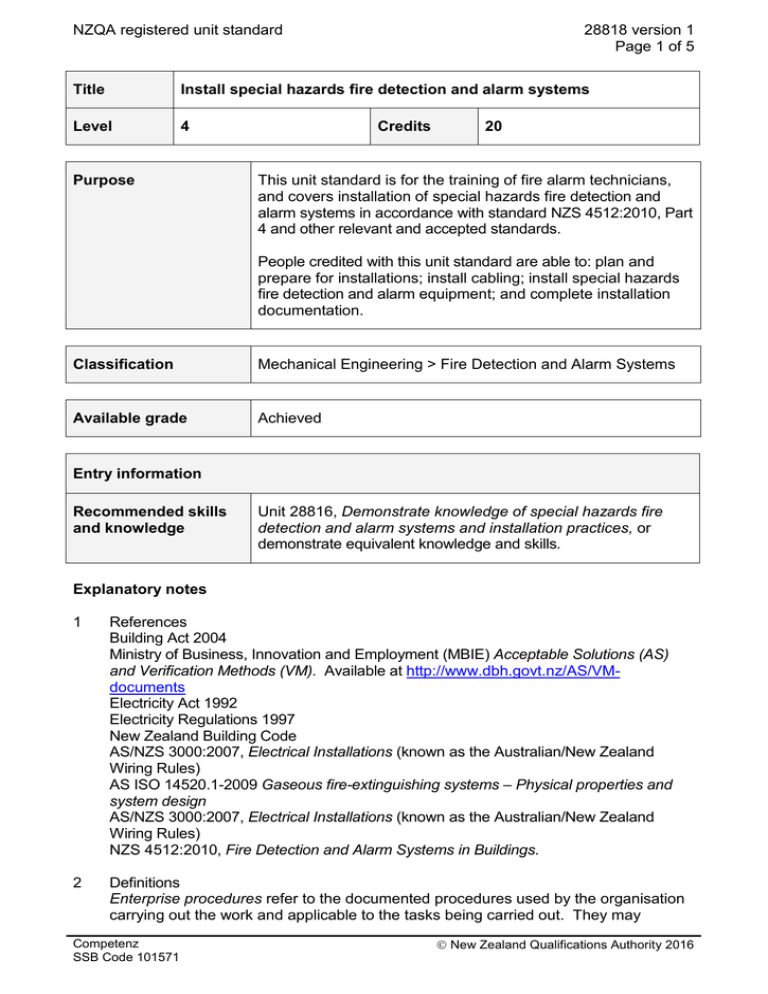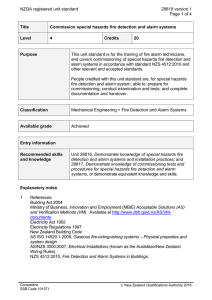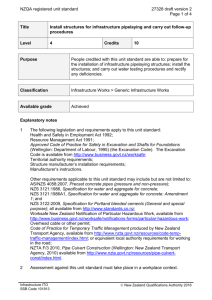NZQA registered unit standard 28818 version 1 Page 1 of 5
advertisement

NZQA registered unit standard 28818 version 1 Page 1 of 5 Title Install special hazards fire detection and alarm systems Level 4 Purpose Credits 20 This unit standard is for the training of fire alarm technicians, and covers installation of special hazards fire detection and alarm systems in accordance with standard NZS 4512:2010, Part 4 and other relevant and accepted standards. People credited with this unit standard are able to: plan and prepare for installations; install cabling; install special hazards fire detection and alarm equipment; and complete installation documentation. Classification Mechanical Engineering > Fire Detection and Alarm Systems Available grade Achieved Entry information Recommended skills and knowledge Unit 28816, Demonstrate knowledge of special hazards fire detection and alarm systems and installation practices, or demonstrate equivalent knowledge and skills. Explanatory notes 1 References Building Act 2004 Ministry of Business, Innovation and Employment (MBIE) Acceptable Solutions (AS) and Verification Methods (VM). Available at http://www.dbh.govt.nz/AS/VMdocuments Electricity Act 1992 Electricity Regulations 1997 New Zealand Building Code AS/NZS 3000:2007, Electrical Installations (known as the Australian/New Zealand Wiring Rules) AS ISO 14520.1-2009 Gaseous fire-extinguishing systems – Physical properties and system design AS/NZS 3000:2007, Electrical Installations (known as the Australian/New Zealand Wiring Rules) NZS 4512:2010, Fire Detection and Alarm Systems in Buildings. 2 Definitions Enterprise procedures refer to the documented procedures used by the organisation carrying out the work and applicable to the tasks being carried out. They may Competenz SSB Code 101571 New Zealand Qualifications Authority 2016 NZQA registered unit standard 28818 version 1 Page 2 of 5 include but are not limited to – standard operating procedures, site safety procedures, equipment operating procedures, codes of practice, quality assurance procedures, housekeeping standards, charging of time and materials, management of drawings and documentation, procedures to comply with legislative and local body requirements. Equipment specifications refer to manufacturer’s specifications for installation, operation, and performance of their equipment. Fire detection and alarm system refers to an installation of apparatus, which performs specified fire related functions in response to the operation of a detector, manual call point, or other input. It includes manual call points, detectors, control and indication equipment, alerting devices, interconnections, fittings, labels, energy sources, and remote signalling devices and may include emergency warning and intercommunication systems (EWIS) where applicable. Industry practice refers to the safe and sound trade practice generally accepted by competent persons within the fire protection industry. Installation specifications refer to the specifications for all details of a particular installation. Typically this includes installation drawings, installation procedures, parts and cabling schedules, test and commissioning procedures, and verbal instructions. Special hazards fire detection and alarm system refers to fire detection and alarm systems which apply electrical actuation to operate mechanical extinguishing systems. It includes water based, chemical, and clean agent gas flood installations. Standards refer to AS ISO 14520.1-2009, NZS 4512:2010, and AS/NZS 3000:2007. 3 Range a All activities must comply with relevant legislative and/or regulatory requirements and recognised codes of practice. b All activities must be completed and reported within agreed timeframes. c All installation work must comply with the Building Code, and standards AS/NZS 3000:2007, NZS 4512:2010, and other relevant and accepted standards. 4 Assessment For assessment purposes, competence must be demonstrated on at least three systems with at least one gas flood system. Outcomes and evidence requirements Outcome 1 Plan and prepare for installation of special hazards fire detection and alarm systems. Evidence requirements 1.1 Site access and timing of the installation and commissioning work are established from contract and installation specifications, and agreed with customer. 1.2 Site occupational safety and health implications for self and others are identified and control measures put in place. Competenz SSB Code 101571 New Zealand Qualifications Authority 2016 NZQA registered unit standard 28818 version 1 Page 3 of 5 1.3 Construction and schematic diagrams are read and explained with references to the installation of fire detection and alarm systems, and any special requirements are identified and explained. 1.3 Materials are purchased or drawn from stock and delivery to the site confirmed in accordance with enterprise procedures. Outcome 2 Install cabling. Evidence requirements 2.1 Cable support systems are installed in accordance with standards and installation specifications. Range support systems – trunking, conduit, catenary wires, cable trays. 2.2 Cable barriers are penetrated and reinstated in accordance with standards and installation specifications. 2.3 Cables are selected and installed in accordance with standards and installation specifications. 2.4 Cable and cable support systems installed comply with passive fire protection specifications for the site in accordance with job specifications and enterprise procedures. Outcome 3 Install special hazards fire detection and alarm system components. Range components – control equipment including power supply, detectors, manual call points, alerting devices, zone control and indicating units. Evidence requirements 3.1 Components are positioned and fitted in accordance with standards, and installation and component specifications. 3.2 Fixings, fastenings, and supports are installed in accordance with industry practice and enterprise procedures. 3.3 Equipment and surroundings are not impaired by the process of installation. 3.4 Wiring connections are made in a manner that ensures safe and reliable contacts. 3.5 Arrangements for connection to power are made in accordance with enterprise procedures. 3.6 Equipment is labelled in accordance with standards. Competenz SSB Code 101571 New Zealand Qualifications Authority 2016 NZQA registered unit standard 28818 version 1 Page 4 of 5 3.7 Controllers are configured and appropriate software is loaded. 3.8 Installation tests are completed in accordance with installation and equipment specifications, and enterprise procedures. 3.9 Remedial action taken as a result of penetrations and any other damage to passive fire protection systems as a result of component and system installation is completed to meet the passive fire protection system compliance. 3.10 Sites are restored in accordance with enterprise procedures following completion of installation. 3.10 Management is kept informed of installation progress in accordance with enterprise procedures. Outcome 4 Complete installation documentation. Evidence requirements 4.1 Log books and documentation for the site are supplied in accordance with standards. 4.2 Drawings are marked up to show as-built condition and processed in accordance with enterprise procedures. 4.3 Installation documentation is completed and distributed in accordance with standards and enterprise procedures. Planned review date 31 December 2020 Status information and last date for assessment for superseded versions Process Version Date Last Date for Assessment Registration 1 15 October 2015 N/A Consent and Moderation Requirements (CMR) reference 0013 This CMR can be accessed at http://www.nzqa.govt.nz/framework/search/index.do. Please note Providers must be granted consent to assess against standards (accredited) by NZQA, before they can report credits from assessment against unit standards or deliver courses of study leading to that assessment. Industry Training Organisations must be granted consent to assess against standards by NZQA before they can register credits from assessment against unit standards. Competenz SSB Code 101571 New Zealand Qualifications Authority 2016 NZQA registered unit standard 28818 version 1 Page 5 of 5 Providers and Industry Training Organisations, which have been granted consent and which are assessing against unit standards must engage with the moderation system that applies to those standards. Requirements for consent to assess and an outline of the moderation system that applies to this standard are outlined in the Consent and Moderation Requirements (CMRs). The CMR also includes useful information about special requirements for organisations wishing to develop education and training programmes, such as minimum qualifications for tutors and assessors, and special resource requirements. Comments on this unit standard Please contact Competenz at qualifications@competenz.org.nz if you wish to suggest changes to the content of this unit standard. Competenz SSB Code 101571 New Zealand Qualifications Authority 2016


